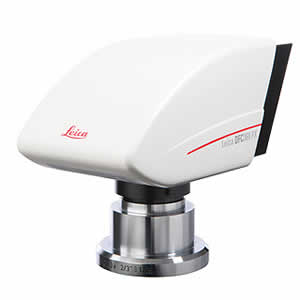Leica DFC360 FX Monochrome Fluorescence Digital Camera
Leica Updated: 2009-02-07 RSS
Ultrafast, High-Resolution Fluorescence Image Recording
Speed is often the deciding factor for successful imaging in demanding high-resolution image documentation of living cells, molecular processes and rapidly fading fluorescence specimens. The monochrome digital camera Leica DFC360 FX is designed to produce brilliant images at maximum temporal resolution. Thanks to state-of-the-art CCD technology, the new camera system achieves maximum frame rates of 20 fps for full frame up to more than 100 fps in binning mode. The highly sensitive sensor and active Peltier cooling ensure a high dynamic range even for low light intensities. The Leica DFC360 FX is the ideal solution for excellent results in live cell imaging.
Key Features
* Fast data transmission via FireWire IEEE1394b
* 20 frames per second and up to more than 100 frames per second for binning mode due to overlapping mode and interline sensor
* Highly sensitive 1.4 megapixel CCD in the visible and infrared spectrum
* Ideal for living cells and rapidly fading fluorescence specimens
* High linearity over the whole dynamic range and minimum noise
* Temperature-controlled Peltier cooling
* The progressive scan of each exposure provides complete full images without disturbing horizontal skipping artefacts
* 12 or 8 bit digitization option allows the selection of the right degree of detail for the particular application.
* Partial Scan Mode: Ultrafast read-out of definable areas at full resolution, also in overlapping mode and in combination with binning
* Camera power supply and fast data transmission via FireWire IEEE1394 b
* Trigger port for exact synchronization (e.g. via CTR7000)
* Shutter speeds from 4µs to 10 minutes
* Long integration times and up to tenfold signal amplification
* Easy installation on to the microscope
* Connection of PC and MAC via TWAIN and FireCam
* Full system integration in Leica Application Suite (LAS) and Leica Application Suite Advanced Fluorescence (LAS AF)
Leica Imaging – Ultrafast Image Recording
Extremely high frame rates determined only by the necessary shutter speed: With the overlapping mode, the 2/3" Progressive Scan CCD sensor reads out imaging data while the next exposure is being taken. The optimized sensitivity of the sensor allows shorter exposure times for rapidly fading fluorescence specimens and a significant reduction of the excitation light for sensitive living cells. Microlenses on each chip ensure a high quantum yield right into the near infrared range.
The light sensitivity and the frame rate can be further enhanced by binning for example over 100 fps with 8x8 binning. If the picture area is reduced for detailed analysis, the recording speed increases. Binning and region of interest can be used, as can multi-channel experiments with different amplifications, in the fast overlapping mode. The active Peltier cooling minimizes the dark current and guarantees noise-free images even at low light intensities. With shutter speeds of 4 μs to 10 minutes and up to tenfold signal amplification, the Leica DFC360 FX offers maximum flexibility.
Convincing System Solutions
Harnessing high-end CCD technology for high-resolution, ultrafast fluorescence image recording, the Leica DFC360 FX provides the ideal solution for excellent live cell imaging results. Integrated imaging systems such as the Leica AM TIRF MC or Leica AF7000 offer optimally matched components and therefore perfect time and light management. The Leica DFC360 FX proves its full performance potential with ultrafast fluorescence filter wheels, high-precision light sources and perfect sequencer synchronization, satisfying even such demanding applications as Ca++ and FRET experiments.
The Leica Application Suite LAS enables intuitive, convenient image acquisition and image processing and is compatible with both PC and MAC systems. Leica's LAS AF Advanced Fluorescence Software is ideal for swift and effective control of experiments such as z-stack, multi-channel fluorescence with overlay, 3D deconvolution, timecontrolled analysis and many other applications. Ultrafast, uncomplicated data transmission is ensured by the FireWire1394b interface.
User Manual
Related Manuals
Leica DFC340 FX Digital Camera
Leica DFC400 Digital Camera
Leica DFC420 Digital Camera
Leica DFC420 C Digital FireWire Camera
Leica DFC490 Digital Camera
Leica DFC500 Digital Camera
Leica IC D Digital Firewire Color Camera
Leica IC 3D Stereomicroscopes Digital Color Camera
Leica MPS30 Analogue Photo System
Leica MPS60 Analogue Photo System
Leica IC A Integrated Video Camera
Leica ICC A Analogue Video Camera